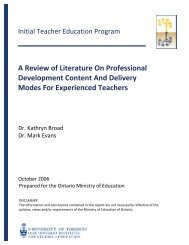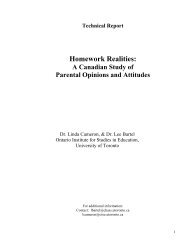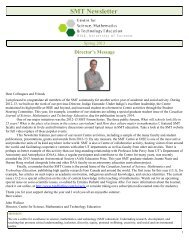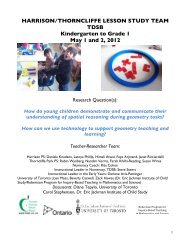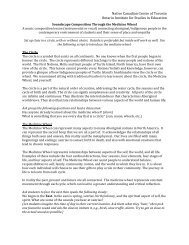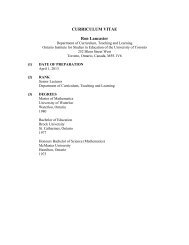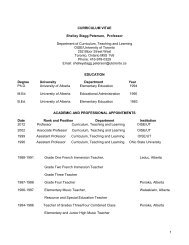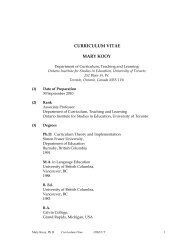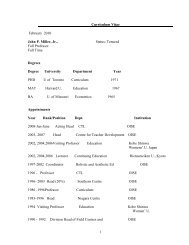The Ontario Curriculum, Grades 9-12 - Ministère de l'éducation ...
The Ontario Curriculum, Grades 9-12 - Ministère de l'éducation ...
The Ontario Curriculum, Grades 9-12 - Ministère de l'éducation ...
Create successful ePaper yourself
Turn your PDF publications into a flip-book with our unique Google optimized e-Paper software.
D2.2 investigate the principles of the natural greenhouse effect, using simulations, diagrams,<br />
and/or mo<strong>de</strong>ls, and compare these principles to those of an actual greenhouse [PR, AI]<br />
D2.3 use a research process to investigate a source of greenhouse gases (e.g., <strong>de</strong>caying<br />
garbage, animal digestive processes, burning biomass) and its effect on a region of<br />
Canada (e.g., melting of the polar ice cap in the Arctic, shrinking of glaciers in the<br />
Rockies) [IP, PR, AI]<br />
D2.4 conduct an inquiry to <strong>de</strong>termine how different factors (e.g., an increase in surface<br />
temperature, an increase in water temperature) affect global warming and climate<br />
change [PR]<br />
D2.5 investigate their personal carbon footprint, using a computer simulation or numerical data<br />
(e.g., <strong>de</strong>termine carbon emissions that result from their travelling to school, work, and<br />
recreation venues; from vacation travelling; from buying products imported from distant<br />
countries), and plan a course of action to reduce their footprint (e.g., a plan to increase<br />
their use of bicycles or public transit; to eat more local foods) [PR, AI, C]<br />
D2.6 compare different tools or systems used by scientists to make informed <strong>de</strong>cisions on<br />
global climate change (e.g., Ecoregions of Canada, bioclimate profiles) [PR, AI]<br />
D2.7 compare different perspectives and/or biases evi<strong>de</strong>nt in discussions of climate change in<br />
scientific and non-scientific media (e.g., with reference to knowledge, beliefs, and/or<br />
values) [PR, AI]<br />
D3. Un<strong>de</strong>rstanding Basic Concepts<br />
D3. <strong>de</strong>monstrate an un<strong>de</strong>rstanding of various natural and human factors that contribute to<br />
climate change and global warming<br />
D3.1 <strong>de</strong>scribe the principal components of Earth’s climate system (e.g., the sun, oceans, and<br />
the atmosphere; the topography and configuration of land masses)<br />
D3.2 <strong>de</strong>scribe the natural greenhouse effect, its importance for life, and the difference between<br />
it and the anthropogenic greenhouse effect<br />
D3.3 <strong>de</strong>scribe how heat is transferred and stored in both hydrospheric and atmospheric heat sinks<br />
D3.4 i<strong>de</strong>ntify different greenhouse gases (e.g., carbon dioxi<strong>de</strong>, methane, water vapour, nitrous<br />
oxi<strong>de</strong>), and explain how they are produced naturally in the environment<br />
D3.5 <strong>de</strong>scribe methods by which greenhouse gases are produced by humans (e.g., burning of<br />
biomass, chemical reactions involving pollutants)<br />
D3.6 i<strong>de</strong>ntify the natural and human causes of climate change in the world and, in particular,<br />
how Canada contributes to climate change<br />
D3.7 i<strong>de</strong>ntify indicators of global climate change (e.g., changes in: the mass of glacial and<br />
polar ice, sea levels, wind patterns, global carbon budget assessments, migratory patterns<br />
of birds)<br />
110 Environmental Education, <strong>Gra<strong>de</strong>s</strong> 9−<strong>12</strong>: Scope and Sequence of Expectations, 2011



